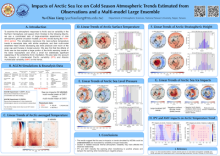Impacts of Arctic sea ice on cold season atmospheric trends estimated from observations and a multimodel large ensemble
Yu-Chiao
Liang
National Taiwan University
Poster
To examine the atmospheric responses to Arctic sea ice variability in the Northern Hemisphere cold season (from October to the following March), we use a coordinated set of large-ensemble experiments of nine atmospheric general circulation models (AGCMs) forced with observed daily varying sea ice, sea surface temperature, and radiative forcings prescribed during the 1979–2014 period, together with a parallel set of experiments where Arctic sea ice is substituted by its climatology. The simulations of the former set reproduce the near-surface temperature trends in reanalysis data, with similar amplitude, and their multimodel ensemble mean (MMEM) shows decreasing sea level pressure over much of the polar cap and Eurasia in boreal autumn. The MMEM difference between the two experiments allows empirically isolating the effects of Arctic sea ice loss, which explain a large portion of the Arctic warming trends in the lower troposphere and drive a small but statistically significant weakening of the wintertime Arctic Oscillation. We also take into account the impacts of interdecadal Pacific variability (IPV) and Atlantic multidecadal variability (AMV) on the trends. The IPV and AMV intensify the warming during their transitioning periods to positive phases and dampen the warming during their transitioning periods to negative phases. The results suggest that the sea ice impacts on trends simulated by AGCMs could be underestimated and modulated by variability at longer timescales, but caution is needed because internal atmospheric variability may have affected the observed relationship.

Poster file
